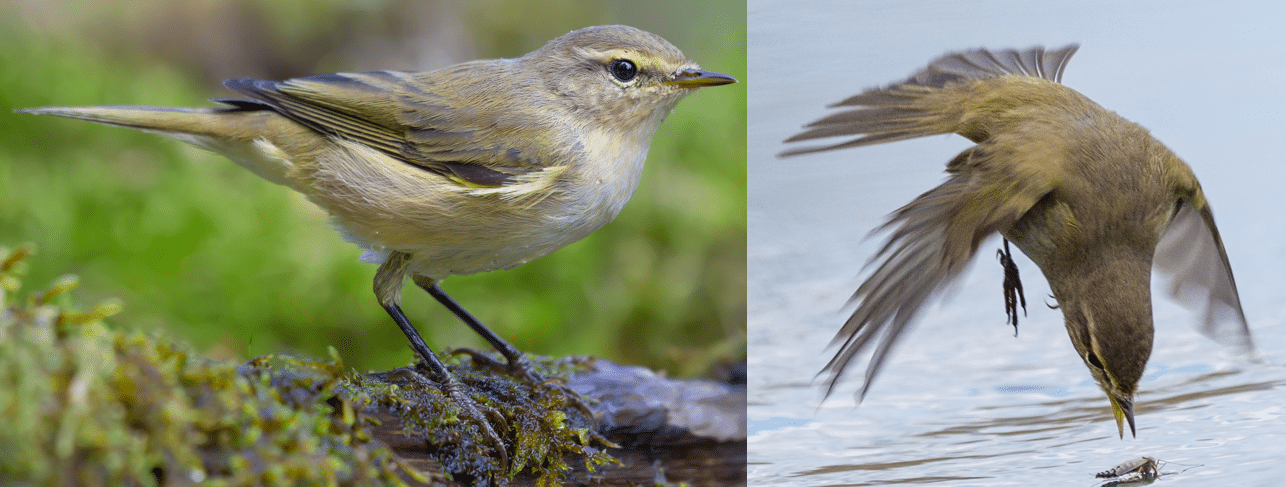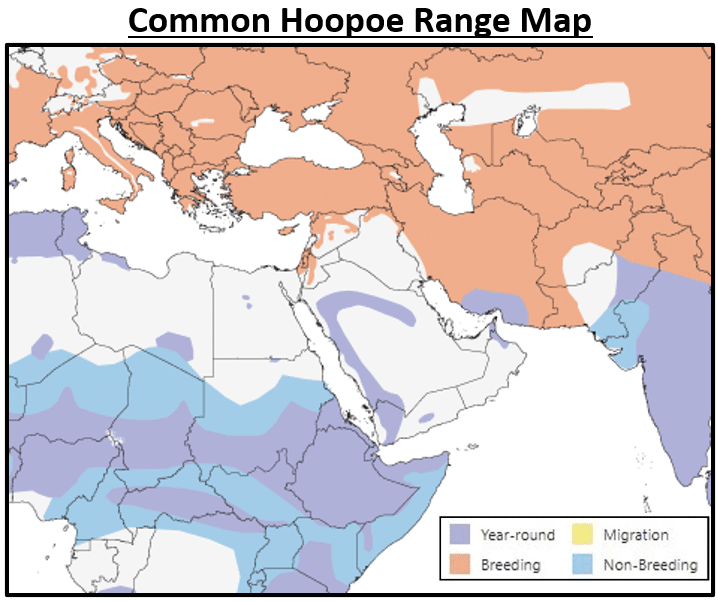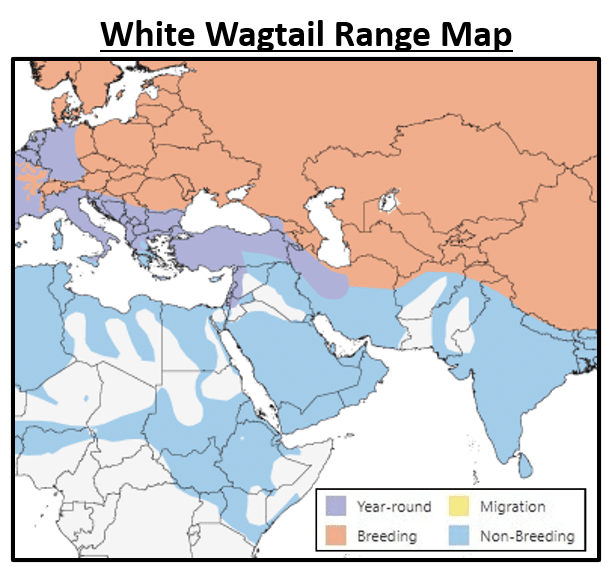14 COMMON Birds Found in Yemen! (2025)
Are you trying to identify a bird found in Yemen?

If so, you’ve come to the right place!
Due to the sheer number of species, there was no way to include EVERY bird in Yemen in this article. So instead, I tried to focus on the birds that are most regularly seen and observed.
14 COMMON birds found in Yemen!
#1. Arabian Babbler
- Argya squamiceps

Identifying Characteristics:
- Adults are 26-29 cm (10-11 in) long with a wingspan of 31-33.5 cm (12.2-13.2 in).
- Their coloring is a dusty gray with brown speckles on the head and shoulders.
- They have powerful legs, long tails, and curved beaks.
Arabian Babblers are communal, gregarious birds that do nearly everything in a group. Look for these birds in Yemen along dry riverbeds with plenty of clear areas. They’ll eat almost anything, including insects, lizards, snakes, plants, and nectar.
One of the most interesting traits of the Arabian Babbler is its affinity for helping other babblers. They’ll even squabble amongst themselves for the chance to help another bird build its nest or feed its babies.
Studies show it may be a status symbol amongst flock members to feed lots of babies, giving that individual social prestige. The more helpful and generous the bird, the higher the status within the flock!

#2. Common Chiffchaff
- Phylloscopus collybita

Identifying Characteristics:
- Adults are 10–12 cm (3.9–4.7 in) long.
- Their coloring is green-tinged brown on the body and brown on the head, with a light line above the eyes.
Common Chiffchaffs are passerine birds, meaning they perch in trees or bushes. You can often spot them standing on just one leg as they sing and chirrup. Most bird watchers consider this species a member of the LBJs, or “Little Brown Jobs”. In ornithological slang, LBJ refers to any bird that is difficult to distinguish from other birds that look essentially the same.
These small warblers eat mostly insects, including eggs and larvae from moths and butterflies. The most common predator of the Common Chiffchaff are domestic cats. Other predators like hawks, weasels, ferrets, and minks don’t make a serious dent in their numbers.
Despite its name being supposedly modeled after its voice, the Common Chiffchaff’s call sounds more like a high, clear “hee-hee.”

#3. Laughing Dove
- Spilopelia senegalensis

Identifying Characteristics:
- Adults are about 25 cm (10 in) long.
- Their coloring is pinkish on the bottom with a lilac-colored head and neck, black eyes, and gray bills.
- Some rufous dots over a largely dark brown chest give it the appearance of wearing a fancy necklace.
Endemic to Yemen, the Laughing Dove is a small pigeon with a long tail. It spends most of its time walking along the ground, looking for food. 
Laughing Doves are highly territorial and mate for life; otherwise, they are solitary. Look for them in dry areas, savannahs with trees, acacia thickets, and similar environments. Their range is also spreading to more urban areas as they adapt to the presence of humans.
The nest of the Laughing Dove is a rough pile of sticks, stems, and roots. Typically, the male dove gathers the materials, and then the female arranges them. However, sometimes they reuse another bird’s nest, even one of a different species.
Their distinctive sounds make Laughing Doves easy to differentiate from other doves and pigeons.

#4. Crested Lark
- Galerida cristata

Identifying Characteristics:
- Adults are about 17 cm (7 in) tall with a wingspan of 29-38 cm (11-15 in).
- Their coloring is pale tan overall, with dark brown streaks on the head, back, and wings.
- This species has a crest on the head that sets it apart from other larks.
The Crested Lark has 33 subspecies, the most of any bird in Yemen.
Their names are as varied as their locations, including the North-west Moroccan crested lark, the West Moroccan crested lark, the North Algerian crested lark, the North-east Algerian crested lark, the Northern Nile Valley crested lark, and the Southern Nile Valley crested lark. It seems as if everyone wants to have their own local Crested Lark version! 🙂
Most of their diet is plant material, but they will occasionally eat beetles and insects, and they certainly don’t mind stealing some farmed grains or seeds. In fact, Crested Larks prefer dry, open land areas, such as fields of cereal grains or roadsides. But, oddly enough, it’s also found near human structures and commercial industry locations such as docks, railways, and airports, favoring sandy patches of ground.
The songs of a Crested Lark are varied and complex, from gargling and warbling trills to mimicry of other birds.

#5. Palestine Sunbird
- Cinnyris osea

Identifying Characteristics:
- Adults are 8 to 12 cm (3.1-4.7 in) long and only weigh 6.8-7.5 grams (about 1/4 ounce).
- They have glossy black feathers that shine greenish-blue in the sunlight.
- Their black bills are long, thin, and curved downward.
Palestine Sunbirds are often mistaken for hummingbirds in Yemen.
This is because they are of a similar size, eat nectar and small insects, and hover in flight. But these two birds are only distantly related, as hummingbirds are only found in the western hemisphere, and sunbirds only live in the eastern hemisphere.
This is an example of convergent evolution, where two unrelated species evolve similar traits and characteristics, resulting from having to adapt to similar environments, such as the beaks and tongues of sunbirds and hummingbirds.
Sunbirds and hummingbirds evolved to meet the demands of their environments without being related. For example, their long curved beaks, brush-like tongues, and small bodies allow them to use nectar for energy while they hunt for insects to give them added nutrition.
Palestine Sunbirds are so comfortable around people that they will sometimes build their nests indoors near humans! If you live in this bird’s range during the breeding season, leaving your windows open might invite some unexpected house guests.
Sunbirds have a loud song for such a petite bird; it sounds a bit like “taw-wee, taw-wee, taw-wee.”

#6. Northern Wheatear
- Oenanthe oenanthe

Identifying Characteristics:
- Adults are 14.5–16 cm (5.7–6.3 in) long.
- Males are grayish-white over most of their bodies, with a rufous chin and a black stripe over the eye. Their wings are predominantly black.
- Females are mostly rufous, with a brownish back and darker brown wings.
This tiny bird has an impressive travel itinerary!
Every year during migration, the Northern Wheatear makes a record-setting journey, crossing deserts, ice fields, and oceans. The Northern Wheatear spends its winters in the sub-Saharan region of Africa, then travels across the Northern Hemisphere to its remote breeding locations in Asia, Europe, Greenland, Canada, and Alaska. Once autumn rolls around, they again take to the sky and head back to Africa.
Northern Wheatears are about as large as House Sparrows, and no other bird of its size has a comparably long migration route. The total distance covered is 30,000 kilometers (18,641 miles)!
This species’ alarm call is a “chuck-chuk-chuk-TWEE” repeated continuously. On the other hand, their song is an ever-changing mix of warbles, tweets, and chirrups.

#7. Eurasian Kestrel
- Falco tinnunculus

Identifying Characteristics:
- Adults are 32–39 cm (12.5–15.5 in) long with a wingspan of 65–82 cm (25.5–32.5 in).
- Their coloring is ruddy brown and black, often with a checkerboard pattern on the back and wings.
- Males have a slate-blue head and white chin.
- Both sexes have bright yellow legs and eye-rings and large black eyes.
This bird of prey in Yemen is a member of the falcon family.
The Eurasian Kestrel uses three distinct hunting techniques. First is the hover approach, where they face the wind and float in the air, using their keen eyesight to spot prey. Second is the ridge flight, using updrafts to provide lift as they coast along effortlessly, which helps them cover a lot of territory with very little effort.
The third hunting technique conserves even more energy. They post themselves on an overhanging tree limb and survey the immediate vicinity. Then, they perform a steeply-pitched dive when they spot prey, grabbing it from the ground. Their diet is almost exclusively voles, mice, and shrews.
Eurasian Kestrels are very vocal in flight, and their call is a “chit-chit-chit” sound.

#8. White Spectacled Bulbul
- Pycnonotus xanthopygos

Identifying Characteristics:
- Adults are 20–25 cm (7.9–9.8 in) long with a wingspan of 20–25 cm (7.9–9.8 in).
- Their coloring is mostly white, mottled with light brown. The head and face are black, and they have brilliant yellow feathers under the black tail.
- This species has white eye rings, which is how it got its common name.
Look for the White Spectacled Bulbul in suburban gardens, populated cities, and on fruit plantations. Breeding populations of this bird in Yemen prefer areas with plenty of trees since they use leaves and twigs to build their nests.
This agile bird feeds most often at dusk when it takes flight and snatches insects right out of the air. They supplement their insect diet with berries, fruit, and seeds.
Their call is a reedy “whee-too-too.”

#9. Little Egret
- Egretta garzetta

Identifying Characteristics:
- Adults are 55–65 cm (22–26 in) long with an 88–106 cm (35–42 in) wingspan.
- They are white with black bills and legs and yellow eyes and feet.
- Their necks have a strong “S” curve and a thin tuft of long feathers on the head.
These aquatic birds in Yemen are almost always found near water.
Look for Little Egrets along coastlines and larger inland waterways like lakes and rivers. They catch fish, crustaceans, and insects directly from the water while standing in the shallows or flying over the surface.
The population of the Little Egret has been threatened by overhunting not once but twice throughout history. First, during the Middle Ages, this species was hunted for food to near extinction. Then in the late 1800s, Little Egrets were threatened once more by overhunting for their feathers.
Luckily, they have since been protected by conservation laws and are now considered a species of least concern. It’s got to be persistent to have survived all that!
#10. Common Hoopoe
- Upupa epops

Identifying Characteristics:
- Adults are 25–32 cm (9.8–12.6 in) long with a wingspan of 44–48 cm (17–19 in).
- Its coloring is cinnamon-brown on the head and body, with black and white barred wings.
- The head is adorned with a crest of brown feathers tipped in black.
Look for the Common Hoopoe in rural gardens, cities, plantations, savannas, and grasslands. They often spend time near piles of rotting leaves or a fallen log, where insects, grubs, and worms will use it as a habitat. It’s like a buffet for the Hoopoe!
This unusual-looking bird has a variety of defensive tactics. Its movable crest is used for advertising and intimidating potential predators and rival Hoopoes. If that doesn’t work, this species is ready for a fight! They use their strong head and neck muscles to gouge their long, pointed beaks into opponents’ eyes, which can blind them.
In addition to their fighting skill and intimidating looks, they produce a substance that smells of rotting meat. They cover themselves and their eggs with the substance to warn away predators. Nestlings even have their own scent gland that makes them unappetizing to predators.
#11. Black Kite
- Milvus migrans

Identifying Characteristics:
- Adults are 48-60 cm (19-24 in) long with a wingspan of about 150 cm (59 in).
- Their coloring is dark brown to brownish red, with a white face.
- The legs are yellow, and the hooked beak is black with yellow at the base.
Although its name suggests a mostly black colored species, the Black Kite is generally dark brown to reddish. It’s easy to mistake this bird in Yemen for other birds of prey, so look closely when identifying!
Black Kites are graceful fliers, soaring over water and open land. They’re adept at catching their prey but will also occasionally eat carrion (road-kill). This species can hunt on the ground and from the air, in addition to visiting garbage dumps looking for edible trash.
This species has a lonely, whistling call that might remind you of a Red-tailed Hawk.

#12. House Sparrow

Identifying Characteristics:
- Males have gray crowns, black bibs, white cheeks, and chestnut on the sides of their faces and neck. Their backs are predominantly brown with black streaks.
- Females are a dull brown color with streaks of black on their backs. Their underparts are light brown. They can be distinguished by the tan line that extends behind their eye.
House Sparrows are native to Yemen but are now one of the world’s most abundant and widespread birds!
In most urban and suburban areas, it’s INCREDIBLY COMMON to see House Sparrows. They owe their success to their ability to adapt and live near humans. Unlike most other birds, they love grains and are commonly seen eating bread and popcorn at amusement parks, sporting events, etc. At your bird feeders, they especially love eating cracked corn, millet, and milo.
House Sparrows can be heard across the entire planet. In fact, pay attention the next time you’re watching the news in another Yemen. Listen for a simple song that includes lots of “cheep” notes.

#13. Rock Pigeon
- Columba livia

Identifying Characteristics:
- A plump bird with a small head, short legs, and a thin bill.
- The typical pigeon has a gray back, a blue-grey head, and two black wing bars. But their plumage is highly variable, and it’s common to see varieties ranging from all-white to rusty brown.
Rock Pigeons are extremely common birds in Yemen but are almost exclusively found in urban areas.
These birds are what everyone refers to as “pigeons.” You have probably seen them gathering in huge flocks in city parks, hoping to get some birdseed or leftover food tossed their way.
Love them or hate them, Rock Pigeons have been associated with humans for a long time! Some Egyptian hieroglyphics suggest that people started domesticating them over 5,000 years ago. And because of these facts, scientists aren’t even sure where their original range was.
These birds are easy to identify by sound. My guess is that you will already recognize their soft, throaty coos. (Press PLAY below)
#14. White Wagtail
- Motacilla alba

Identifying Characteristics:
- Adults are 16.5-19 cm (6.4-7.4 in) long.
- Their coloring is black, white, and dull gray. Their white face and black throat are the most noticeable features.
- This species has long legs, a puffed chest, and a rounded head.
White Wagtails are common across Eurasia, but incredibly, this little guy sometimes ventures all the way to western Alaska for nesting.
This species falls victim to the Common Cuckoo, a brood parasite that lays its eggs in the host’s nest. Usually, a host bird is forced to care for the cuckoo chick, but not White Wagtails. Since they are too small to destroy the eggs, they often abandon an invaded nest and start over.
The White Wagtail got its name from the way it forages along the water’s edge, wagging its tail, looking for insects. They mostly hunt on land but will pursue prey in the air occasionally. Sometimes they wade in shallows or walk atop floating masses of vegetation while on the hunt. Likely prey includes crane flies, midges, mayflies, and aquatic larvae.
Its call is an extremely short and fast pair of high-pitched “chirrups.”

Which of these birds in Yemen have you seen before?
Leave a comment below!














